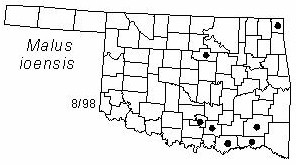Tree to 9 m (30 ft) tall and 50 cm (18 in) in diameter. Crown rounded and spreading. Bark red-brown to dark gray with small narrow scales. Twigs red-brown to gray, densely tomentose when young becoming less so with age; numerous short lateral shoots bearing terminal thorns. Leaves alternate or clustered, simple; elliptic, oblong, or oblong-ovate, 4-13 cm (1.5-5 in) long and 2-10 cm (0.8-4 in) wide; glabrous above, glabrous to densely white tomentose beneath; dark green and lustrous above, rounded or cuneate at base; acute, obtuse or rounded at apex; margins singly or doubly crenate-serrate, some leaves with deep lobes; petioles slender, white tomentose, becoming less so with age. Flowers in clusters, pedicels pubescent, 2.5-4 cm (1-1.5 in) long, with 2-5 flowers; calyx 5-lobed, lanceolate-acuminate, densely white tomentose; petals 5, white or pink, obovate, base narrowed into a claw; styles 5, with dense white hairs; stamens numerous; flowers appear from April to June. Fruits pomes, 2-4 cm (0.8-1.5 in) in diameter, globose, compressed at the ends, green-yellow, waxy or greasy to the touch; fruits mature September to October.
Distribution: Oklahoma, Texas and Arkansas, east to Alabama, north to Minnesota. Rare.
Habitat: moist soils along streams and woodland borders.
Comments: Malus is the classical name for apples; ioensis refers to Iowa.
Field identification: Prairie crab apple can be recognized by its unique leaf shape and tomentose stems and inflorescence.
Horticulture: Prairie crab apple has been cultivated since 1885, primarily for its showy and fragrant flowers.
Food uses: The fruits are hard and sour, but have been used to make jellies, cider and vinegar.
Wildlife benefits: The fruits are eaten by several species of birds and mammals.
NWI status: none
Distribution in Oklahoma: 
BACK
NEXT
RETURN TO INDEX
Last update: 9/14/99
 Go to Oklahoma Biological Survey Home Page
Go to Oklahoma Biological Survey Home Page
 Disclaimer
Disclaimer